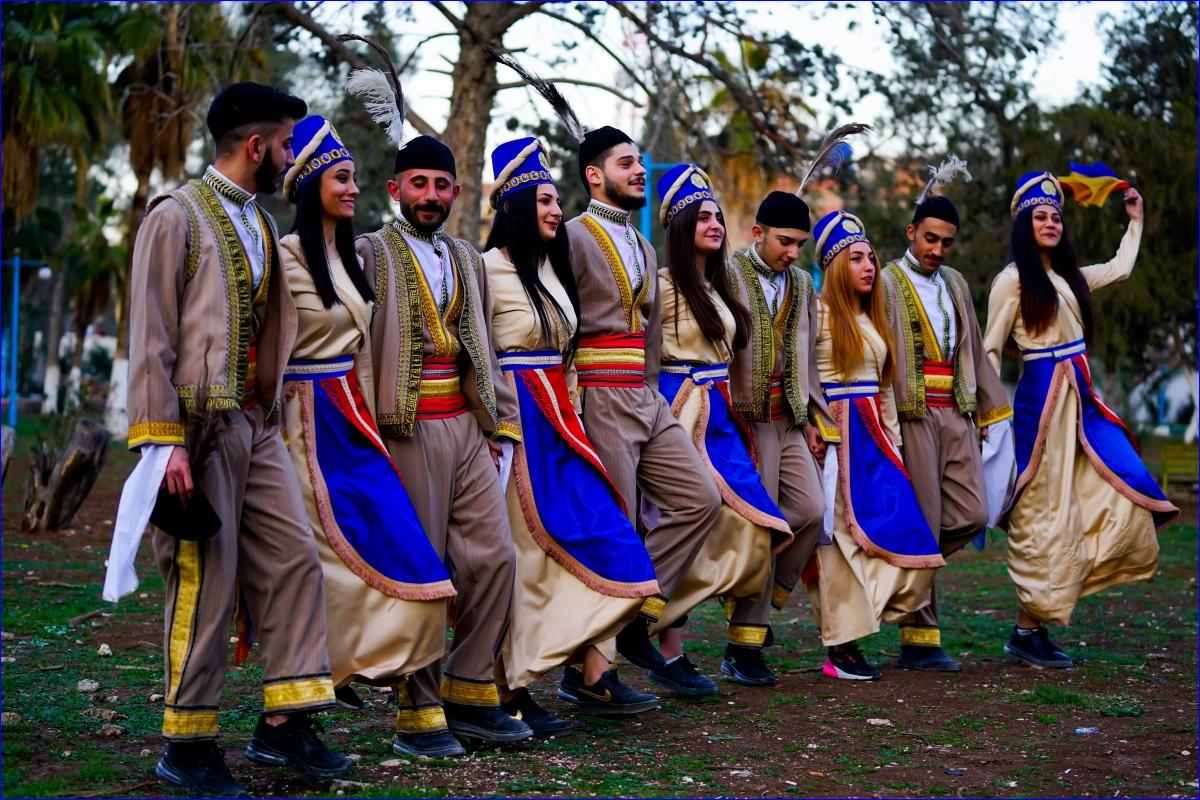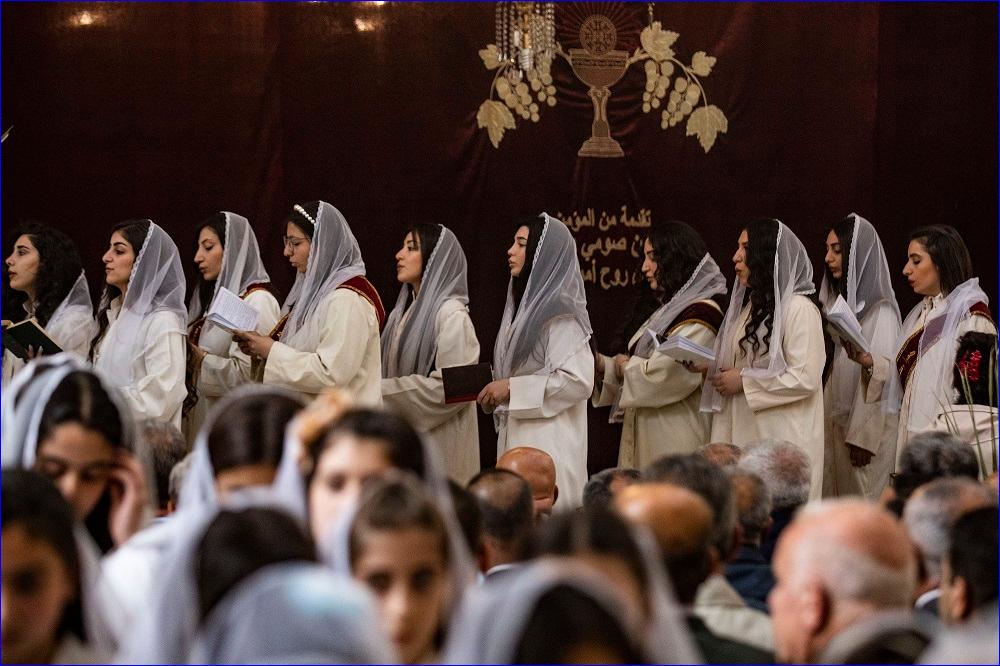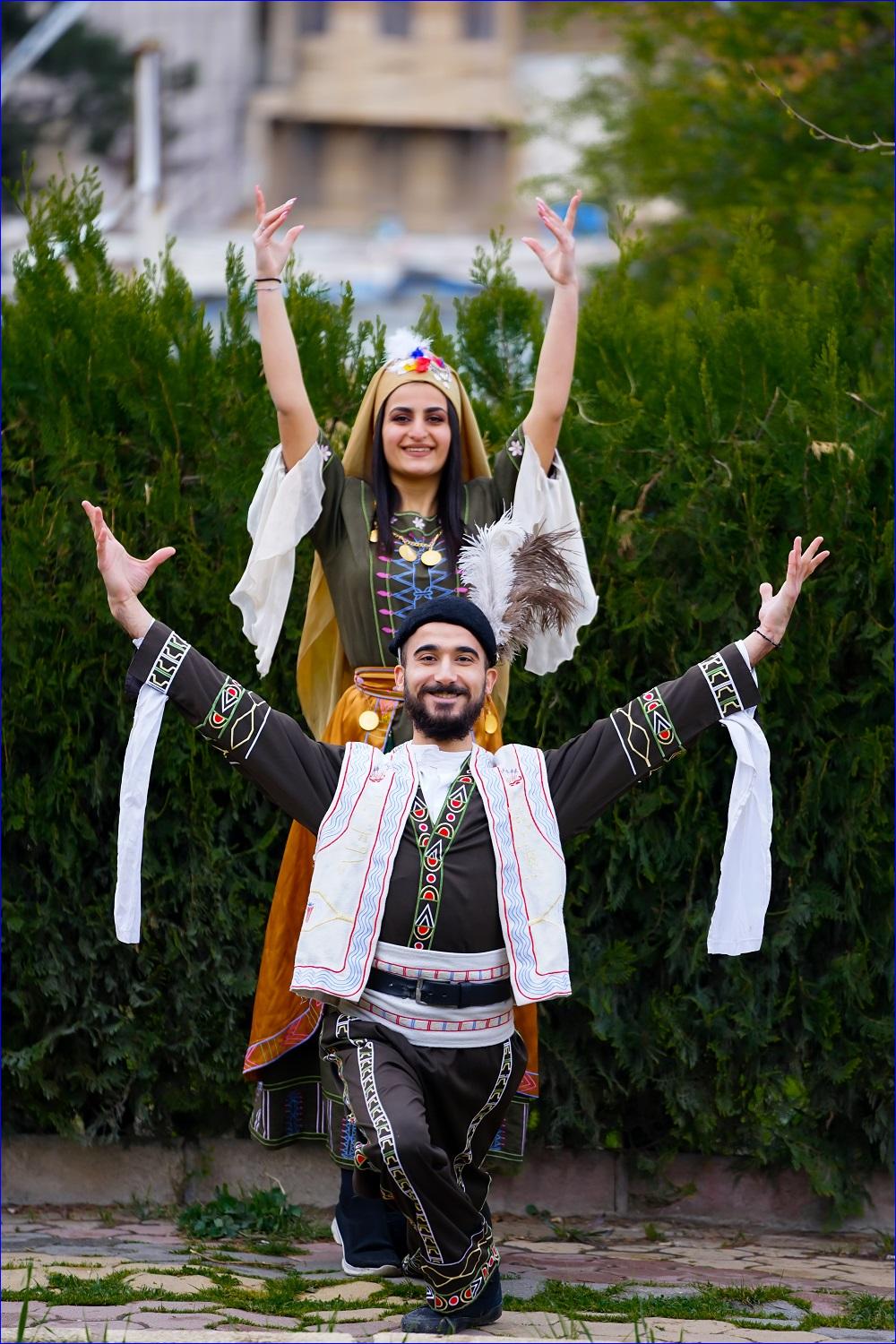


 Rudy Tahlo)
Rudy Tahlo)
In the 1930s and 1940s, the people from these villages were displaced and relocated to the city, naming their new neighbourhoods after their original villages. However, when you inquire about the fate of these people, the residents sadly reveal: "There is no one left. They have all migrated."
The city of Qamishli bustles with activity. Hundreds of workshops in its industrial zone, restaurants, parks, cafes, cinemas, and old mills, as well as libraries, hotels, remnants of palaces belonging to the bourgeoisie class, cultural clubs, and wedding halls -- all bear Assyrian names and signs. However, the Assyrians themselves are no longer present.
Qamishli -- the largest city in north-eastern Syria -- was founded by the Assyrians in the mid-1920s, and for many decades, they formed the backbone of its economic, social, cultural, and administrative structure.
Qamishli served as a model for numerous cities and towns in the wider region of north-eastern Syria, including Al-Malikiyah/Dayrik near the Syrian-Turkish-Iraqi border triangle, and the cities of Tirbespiye/Al-Qahtaniyah, Al-Hasakah, Amuda, Ad Darbasiyah, Ras Al-Ain, Tell Abyad, and Kobani/Ayn al-Arab.
The Assyrians were trailblazers in all these places, as well as the surrounding countryside and towns. However, their numbers started to decline in the 1980s due to various reasons, and now, there are no Assyrians remaining.
The story of the Assyrian people in Syria is reflective of the experiences the wider Christian community in the Middle East. They once flourished and thrived in the middle of the last century, but their presence has gradually diminished over time.
Related: Timeline of ISIS in Iraq
Related: Attacks on Assyrians in Syria By ISIS and Other Muslim Groups
However, the Assyrians are unique in that they never saw themselves as a national or religious minority but rather as an integrated part of the national fabric -- politically, culturally, and economically.
Oldest Christian community in the Middle East
Their roots in Syria are rich and deep -- dating back to ancient times -- and the country's modern name itself is derived from the Assyrians.
Related: Brief History of Assyrians
The Assyrians are the oldest Christian community in the Middle East. Their lineage can be traced back to the ancient Assyrian/Chaldean peoples. They primarily speak the Western dialect of the traditional Aramaic/Assyrian language.
Throughout history, Assyrians have inhabited various regions within Mesopotamia and the eastern Mediterranean coasts.
However, it is the Assyrians in northern Iraq and north-eastern Syria who have managed to preserve their distinct national identity and heritage, distinguishing themselves from other Arab Christian communities.
Elderly Assyrians recall their historic presence in the vast steppes of north-eastern Syria, predating the establishment of the Syrian state in the early 1920s. The Jazira steppes have always served as grazing lands for numerous Assyrian and Kurdish villages situated in the northern Taurus Mountains, overlooking the steppes.
However, due to geopolitical changes, these villages eventually became part of Turkey, resulting in a geographical separation between them and the southern steppes.
For decades, Assyrian peasant families resided in villages such as Chuwajtila, Kirku Shamu, Selhomiye, Khanik, Dearborn, and many others on the Syrian side of the border with Turkey.
Genocide and mass displacement
Tragically, starting in 1915, they became victims of genocidal campaigns alongside the Armenians, orchestrated by the Ottoman Empire. These massacres, known as the Sayfo Massacres, dominate the social and political psyches of Assyrians.
The governor of Nusaybin, Qadour Bey, spearheaded relentless campaigns against the Assyrians of the Syrian Jazira steppes in the early 20th century, forcing hundreds of families to flee their villages.
Many embarked on arduous migrations that reached as far as the American continent, including the family of Archbishop Yeshua Samuel of the Orthodox Church in the United States.

In addition to the villages, the Syrian Jazira steppes were adorned with numerous Assyrian monasteries and religious shrines, serving as symbols of the enduring spiritual and cultural presence of the Assyrians in the region.
Notable sites include the tomb of Saint Febronia in the village of Hemo near Qamishli, the Church in Barbita, and the historic monastery of Dayrik.
The Assyrian presence in the Syrian Jazira region experienced growth in the mid-1920s with the arrival of French military battalions, marking the beginning of the French colonial era in Syria. Prior to this, Assyrians living in the Taurus Mountains had endured genocide alongside the Armenians since 1915, which lasted for a decade.
Neutral sources estimate that two-thirds of the Assyrian population residing across the mountain range, from the Botan Cizîra region to Urfa/Riha, were killed in the massacres.
Migration, collaboration and innovation
In the aftermath of the genocide, tens of thousands of Assyrians fled their historic villages in the mountains and migrated towards the fertile plains in the south. They established new villages or collaborated with Kurdish farmers in some areas.

Another group migrated to the outskirts of the Sinjar Mountains and Lake Khatuniyah, forming partnerships with Arab tribes. Through these alliances, they successfully developed and cultivated vast agricultural lands that were previously unproductive.
Before the genocide, much of the land in the Syrian Jazira region was owned by affluent Assyrian bourgeois families in towns like Ras al-Ain, Amuda, and Dayrik.
These families had traditional relationships with their Kurdish counterparts from the same social class, including the Jamil, Ibrahim Pasha, Haj Darwish, Hajou, and Dakouri families. Prominent Assyrian bourgeois
From the onset of their arrival, the Assyrians proved to be an asset in various developmental sectors within the Syrian Jazira region, which was predominantly comprised Arab Bedouin tribes in the east and south, and Kurdish rural farmers in the northern and western areas.
Prominent Assyrian families like Asfar, Najjar, Doli, Kalushabo, Koj, and Mgheimis revolutionised agriculture by adopting innovative approaches distinct from traditional farming practices. They implemented long-term strategic planning, particularly focusing on strategic crops such as wheat, cotton, and barley.
By the 1950s and 1960s, the Syrian Jazira garnered recognition in Syrian and regional economic circles as the "California of the East".
Assyrian farmers imported cutting-edge machinery from European countries, established connections between agriculture and banking investments, reclaimed barren lands, altered the course of rivers and streams originating from the northern Turkish mountains, and established agricultural development centres with ties to international hubs.
In addition to agriculture, Assyrians played an active role in the industrial sector, encompassing agricultural industries, transformative processes, chemical production, and services. The cities of the Jazira, particularly, catered to the region's needs, manufacturing agricultural machinery, food products, and chemicals.
Additionally, the Assyrians notably excelled in education and social development, leveraging the urban and bourgeois heritage of many Assyrian families as well as the organisational role of the Syriac Orthodox Church.

From the early 1950s onwards, numerous social clubs, cinemas, theatres, cultural festivals, and private Assyrian schools were established throughout different areas of the Syrian Jazira.
While these institutions were primarily founded and administered by Assyrians, they served the diverse population of the region, influencing and inspiring similar cultural, civic, and service initiatives.
What sets the Assyrian experience apart from other Syrian Christian communities, such as the Armenians, is their active involvement in the intricate fabric of Syrian public life, encompassing cultural, bureaucratic, and political domains.
For many decades, Assyrians formed the foundation of the administrative apparatus in state institutions within the Jazira region, especially in the fields of education and public administration.
They integrated into various Syrian political movements, most notably the ruling Ba'ath Party, as well as the Syrian Communist Party, the Syrian Social Nationalist Party, and various leftist and nationalist opposition movements.
A pivotal collective transformation occurred in 1957 when Assyrian politicians and notable figures established the Assyrian Democratic Organisation, marking the first Assyrian political organisation in Syria.
It championed revolutionary demands, including the constitutional recognition of the Assyrian people and their right to education in the Assyrian language, along with other fundamental national rights.
Over time, this organisation evolved into a significant political faction within the Syrian opposition, actively participating in initiatives such as the Damascus Declaration and ultimately culminating in the National Coalition for Syrian Revolutionary and Opposition Forces.
Five phases of Christian decline
Community notables, intellectuals, and observers of public affairs in Syria have closely monitored the five significant stages that have contributed to the dwindling population of Christians, particularly the Syriacs.
Presently, their numbers have been estimated to be less than 15,000 people, constituting a mere 1% of the total population of the Jazira Province.
The first phase commenced with the emigration of highly educated and sophisticated Syriac families who found it difficult to assimilate into the agrarian society and peasant culture of the Syrian Jazira.
Families such as Kourieh, Antoine, Hana, and Haddad relocated to cities like Damascus, Beirut, Aleppo, and Jerusalem, starting from the 1950s.
They seamlessly integrated into their new environments, assuming prominent positions in the social and economic fabric, even securing high-level political roles. For instance, Gebran Kourieh, a Syriac, held the prestigious position of the Syrian presidential spokesman.
The second phase, spanning the three years of Syrian-Egyptian unity (1958-1961), proved to be the most challenging period.
During this time, the ruling authorities, in their pursuit of curbing and eliminating various freedoms, institutions, and political parties, also suppressed the civil bodies and way of life of the Syriacs in Syria. This encroachment affected the Syriacs economically, culturally, ecclesiastically, and civically.
One prominent example of the repression and exclusion of the Syriacs from public life was the closure of the Syriac Al-Rafidain Club. This club had served as a significant platform for fostering the collective spirit of the Syriacs, nurturing cultural, artistic, athletic, and even political endeavours.
The memories and achievements associated with the activities and contributions of this club remain deeply ingrained in the collective consciousness of the Syriac community to this day.
The Ba'ath Party coup in 1963 and Hafez al-Assad's subsequent sole rule over Syria since the early 1970s marked the beginning of the third phase, which witnessed the migration of Syriacs from Syria and a decline in their population percentage.
This period was characterised by an armed power struggle with the Muslim Brotherhood, resulting in widespread terror and unrest throughout the country.
The Syriacs experienced the consequences of the expanding security apparatus first-hand. In 1986, numerous political leaders from the Assyrian Democratic Organisation, including the organisation's secretary and members of the political bureau, were arrested for the first time in its history.
These arrests were related to the organisation's demands and advocacy for the political rights and human rights of the Syriac/Assyrian community in Syria.
One of the key issues that led to these arrests was the organisation's condemnation of government policies that caused the drying up of the Khabur River, which had a significant number of Syriac/Assyrian villages located along its banks.
The arrests spread panic in the Syriac community. Several mayors of Syriac villages were forced by the government security services to issue a joint statement calling for severe punishment to be inflicted upon the detained members of the Assyrian Organisation.
The civil war in the 1980s further exacerbated the situation. Many Syriacs chose to immigrate to Lebanon, looking for a "safe Christian environment," especially since Lebanon had historically been home to several thousand Syriac individuals.
The fourth phase was characterised by economic poverty, which emerged in the early 1990s and contributed to further migration of Syriacs and a decline in their numbers.
Concurrently, a conservative Islamic trend emerged across different regions of the country, resulting in certain social classes perceiving the Syriacs, along with other Christian groups, as distinguished religious and ethnic minorities, leading to discrimination and mistreatment against these groups, whether within governmental circles or in economic and social spheres.
The marginalisation of the Syriacs within their respective neighbourhoods in various cities and their concentration in semi-closed residential areas reflected the social disharmony that plagued them since the early 1990s.
This situation prompted tens of thousands of young Syriac men to migrate from Syria, particularly to Scandinavian countries, which offered them specific advantages, albeit in more discreet ways.
The fifth and final stage of migration for the Syriacs from Syria occurred during the years of the Syrian revolution and the violence and the rise of sectarian and nationalist discourses that accompanied it, intertwined with the overall deterioration of various aspects of life in Syria, all contributed to this stage.

or register to post a comment.